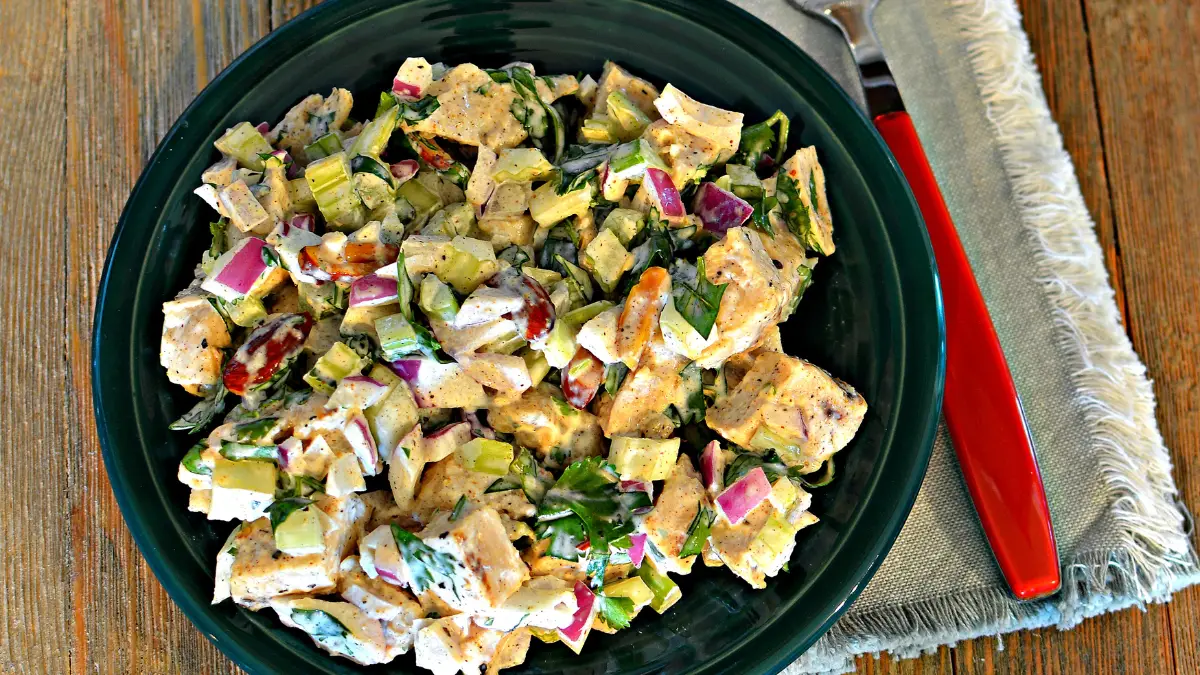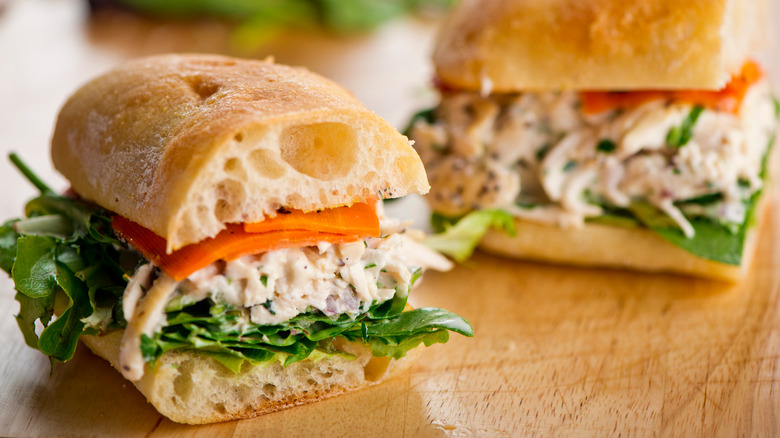Let’s be honest – we’ve all been there. You’re standing in front of your fridge, staring at that container of chicken salad from a few days ago, wondering if it’s still good to eat. I know I’ve played this dangerous game more times than I’d like to admit!
Chicken salad is one of those delicious foods that just hits the spot whether you’re having it for lunch or as a quick snack. But because it contains mayo, chicken, and various fresh ingredients, it can go bad rather quickly. And trust me, you definitely don’t want to mess around with spoiled chicken salad – food poisoning is no joke!
In this article I’ll share all the tell-tale signs that your chicken salad has gone bad, plus some tips on proper storage to make it last longer. Let’s dive in!
How Long Does Chicken Salad Last?
Before we get into the warning signs, let’s talk about shelf life. Generally speaking, properly stored chicken salad will last in the refrigerator for:
- Homemade chicken salad: 3-4 days
- Store-bought chicken salad: Until the expiration date (usually 3-5 days after opening)
- Room temperature: No more than 2 hours
The USDA recommends storing cooked chicken, including that in your chicken salad, for only 3-4 days in the refrigerator This timeline is your first clue – if your chicken salad has been sitting in the fridge for 5+ days, it’s probably best to toss it, even if it looks and smells okay
7 Clear Signs Your Chicken Salad Has Gone Bad
1. Unpleasant or Sour Smell
This is often the most obvious indicator. Fresh chicken salad should have a pleasant aroma. If you open the container and immediately detect a sour, rancid, or just “off” smell – trust your nose! Your chicken salad has likely gone bad.
My advice? Don’t even attempt to taste it to confirm. The smell test is usually sufficient, and it’s not worth risking getting sick.
2. Visible Mold Growth
This one’s a no-brainer. If you see any fuzzy spots or discoloration that looks like mold (typically green, blue, white, or black specks), throw the chicken salad away immediately. Mold can produce harmful toxins that might make you sick, even if you scrape off the visible parts.
3. Discoloration
Fresh chicken salad should have a light, consistent color. The chicken pieces should be white or light tan, depending on whether you used white or dark meat. If the chicken or the mayo-based dressing appears gray, yellowish, or has darkened significantly, it’s a sign of spoilage.
4. Slimy or Unusual Texture
Good chicken salad should have a creamy texture from the mayo or other binding ingredients, with the chicken maintaining some firmness. If your chicken salad feels slimy, excessively watery, or has an otherwise unusual texture when you stir it, it’s probably spoiled.
I remember once I found a container of chicken salad that had somehow separated into layers – there was clear liquid on top and a solid mass beneath. That went straight into the trash!
5. Bubbles or Fizzing
This might sound weird, but if you notice bubbles forming in your chicken salad or it makes a slight fizzing sound when you stir it, that’s a definite sign of bacterial activity. Bacteria produce gases as they multiply, which can cause these bubbles to form.
6. Changes in Taste
If your chicken salad passes the visual and smell tests but tastes sour, bitter, or just “off” in any way – stop eating immediately and throw it out. Never “power through” questionable food just to avoid waste.
7. It’s Been Left Out Too Long
According to food safety experts, perishable foods like chicken salad shouldn’t sit at room temperature for more than 2 hours (or 1 hour if the temperature is above 90°F/32°C). This is because bacteria multiply rapidly in the “danger zone” between 40°F and 140°F.
If you accidentally left your chicken salad out on the counter overnight or during a picnic for several hours, it’s safest to discard it regardless of how it looks or smells.
The Danger Zone: Why Chicken Salad Spoils Quickly
The USDA identifies temperatures between 40°F (4°C) and 140°F (60°C) as the “Danger Zone” for foodborne illnesses. In this temperature range, bacteria can double in number in as little as 20 minutes!
Chicken salad is particularly vulnerable to bacterial growth because:
- Chicken: Poultry is notorious for potentially harboring harmful bacteria like Salmonella and Campylobacter
- Mayonnaise: The moisture and fat content create an ideal environment for bacterial growth
- Mixed ingredients: Chopped vegetables and other add-ins increase surface area for bacteria to multiply
Proper Storage to Extend Shelf Life
Want to make your chicken salad last as long as possible? Here are some essential storage tips:
- Store promptly: After making or serving chicken salad, return it to the refrigerator immediately
- Use airtight containers: Prevent contamination and maintain freshness
- Proper temperature: Keep your refrigerator at or below 40°F (4°C)
- Avoid cross-contamination: Use clean utensils each time you serve from the container
- Don’t leave it out: At parties or picnics, keep chicken salad in a cooler with ice or refrigerate after serving
Can You Freeze Chicken Salad?
Here’s the truth – chicken salad with mayonnaise doesn’t freeze well. Mayo tends to separate when frozen and thawed, resulting in an unappetizing watery mess.
If you absolutely must freeze chicken salad, consider these options:
- Make it with oil-based dressing instead of mayo
- Freeze just the chicken pieces, then add fresh mayo and other ingredients after thawing
FAQs About Chicken Salad Safety
Can I eat chicken salad that’s been in the fridge for a week?
No, I wouldn’t recommend it. Even if it looks and smells fine, chicken salad should be consumed within 3-4 days of preparation when stored properly in the refrigerator.
What happens if you eat bad chicken salad?
Eating spoiled chicken salad can lead to food poisoning with symptoms like nausea, vomiting, diarrhea, abdominal cramps, and fever. These symptoms typically appear within a few hours to a few days after consumption and can last several days.
Is it safe to eat chicken salad left out overnight?
Absolutely not! Chicken salad left at room temperature for more than 2 hours should be discarded, regardless of how it looks or smells.
Why does my chicken salad taste sour?
A sour taste is a clear indication that your chicken salad has started to spoil due to bacterial growth. Do not eat it if it tastes sour.
Can I still eat chicken salad if only part of it looks bad?
No. When it comes to perishable foods like chicken salad, you should follow the rule: “When in doubt, throw it out.” Bacteria and their toxins can be present throughout the food even if only part of it shows visible signs of spoilage.
When to See a Doctor
If you accidentally consumed spoiled chicken salad and are experiencing severe symptoms like:
- High fever (over 101.5°F)
- Blood in your stool
- Severe dehydration (extreme thirst, dry mouth, little or no urination)
- Diarrhea lasting more than 3 days
- Vomiting that prevents you from keeping liquids down
Seek medical attention immediately, as these could be signs of a serious foodborne illness that requires treatment.
Creative Uses for Leftover Chicken Salad
Got chicken salad that’s still good but you need to use it up quickly? Here are some ideas:
- Stuff it into hollowed bell peppers
- Serve in lettuce wraps for a low-carb option
- Use as a topping for a green salad
- Make chicken salad pinwheels with tortillas
- Fill celery sticks or cucumber boats
- Add to grain bowls with rice or quinoa
- Stuff into avocado halves
Final Thoughts
When it comes to chicken salad safety, it’s always better to be cautious. I’ve learned the hard way that saving a few dollars by eating questionable food isn’t worth the risk of spending the night hugging the toilet!
Remember the key signs: unusual smell, mold, discoloration, slimy texture, bubbles, or off taste. And when in doubt, remember the golden rule of food safety – throw it out!
Do you have any special tricks for keeping your chicken salad fresh longer? Or maybe a horror story about eating chicken salad gone bad? Share in the comments below!

How to keep your chicken salad safe as long as possible

Several factors encourage bacteria to multiply on your food: temperature, oxygen, time, lack of acidity, and moisture. A multi-pronged approach to combat all five will help keep germs at bay and your chicken salad safe. To tackle temperature, store your chicken salad in the coldest spot in the fridge. Usually, this is in the back or bottom. It is definitely not in the door, which is opened frequently and exposed to warm outside air.
An airtight seal on whatever bag or container you use to store your salad will lock out oxygen and moisture. When it comes to acidity, bacteria love a neutral pH environment. Adding an acid to your recipe can help — this could be a splash of vinegar or citrus juice (plus, you get a bonus dash of flavor).
Unfortunately, the time factor is out of your control, but an obvious move is to limit the time your salad spends in the Danger Zone. Once bacteria enter their comfy and preferred temperature range, they can double in number after just 20 minutes. Your salad wont be dangerous to eat, but its total shelf life will likely decrease.
